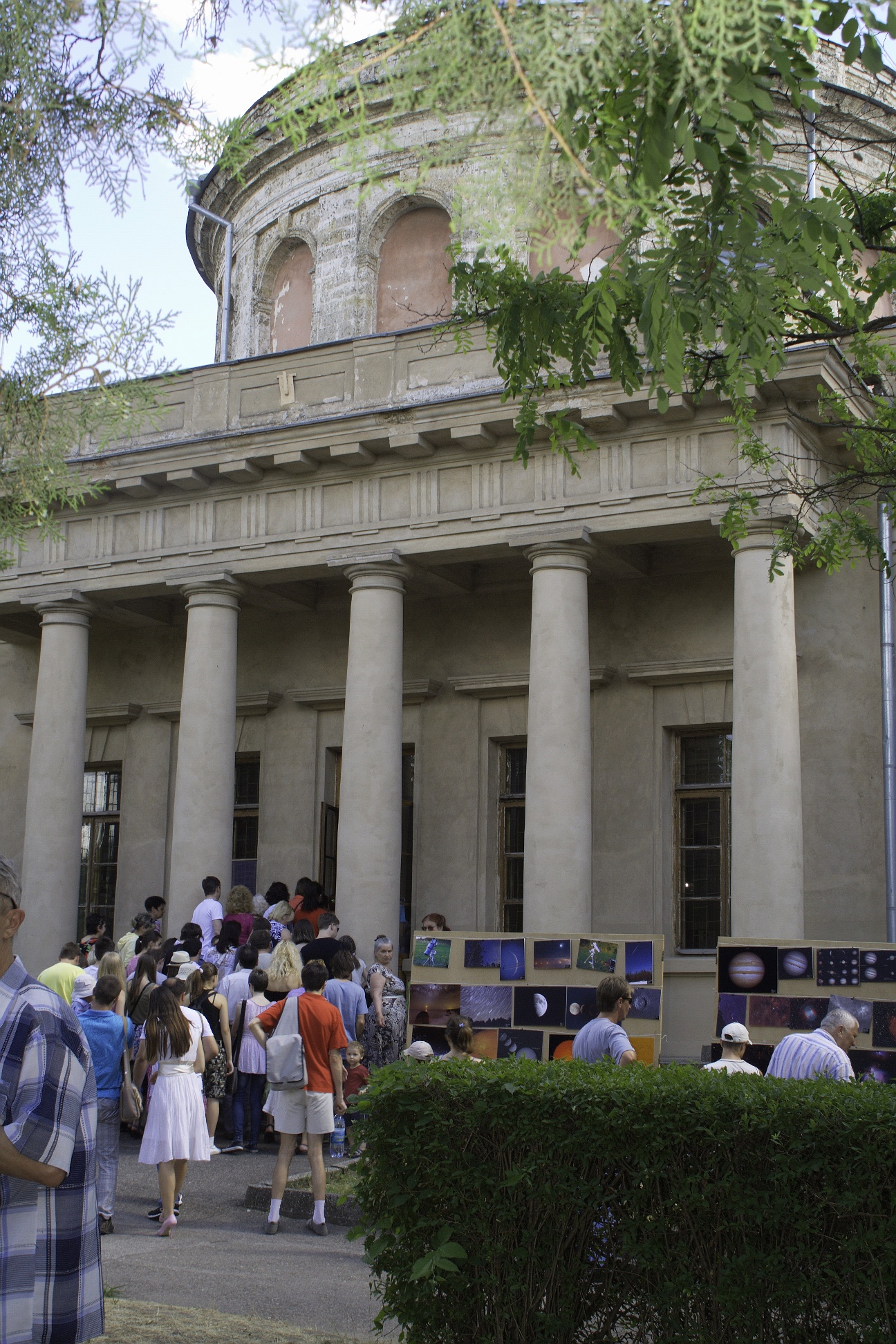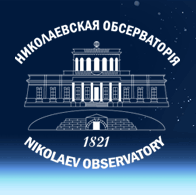|
2013-05-14 12:00:57
 Research Institute "Nikolaev Astronomical Observatory" (RI NAO) conducted activities dedicated to the Day of Science in Ukraine: Research Institute "Nikolaev Astronomical Observatory" (RI NAO) conducted activities dedicated to the Day of Science in Ukraine:
1) On the 18th of May 2013, Open House was held at the observatory from 12 noon to 19:00. The program consisted of the excursion to the museum as well as to the current and historical telescopes.
2) On the 21st of May 2013, a ceremonial meeting of the Scientific Council was held at 11-00 in the Round Hall with participation of representatives from educational and cultural community of Nikolaev. The meeting agenda was devoted to the following anniversaries:
Nikolaev branch of Pulkovo Astronomical Observatory (1913 - 1991);
Academician Andrei B. Severny (1913 - 1987);
The 70 anniversary of Gennady I. Pinigin, director of the RI NAO.
Nikolaev branch of Pulkovo Astronomical Observatory (1913 - 1991)
Until 1911, the observatory was subordinated to the Naval Ministry. In 1912 - 1991, the observatory became the Southern Department of Pulkovo Observatory. The spreading of the Pulkovo absolute stellar catalogues towards the southern sky and carrying out regular observations of the Sun and the solar system bodies were the main objectives of the observatory during this period. The Vertical Circle made by Repsold and the Transit Circle made by Freiberg-Kondratiev were moved from Odessa to equip the new observatory. During the period of greatest upheaval in the life of our society: the First World War, Revolution and the Civil War, the observatory managed to survive and be preserved as a research institution. Boris Pavlovich Ostaschenko-Kudryavtsev (1879-1956) was the director in this period of time. Revival of the observatory after hardship is associated with the name of the fourth director Leonid Ivanovich Semenov (1878-1965), who headed the observatory in 1923. In 1931, the highly accurate time service was created. This service had been involved in national and international programs to determine the exact time. In 1935, the observatory was included in the Academy of Sciences of the USSR. During the Great Patriotic War from August 1941 to March 1944, the observatory was located in the area of the German occupation. Director L. Semenov managed to save the observatory from serious damage and destruction.
During the post-war revival period, James E. Gordon (1912-1978) was appointed in charge of director of the observatory in 1951. In 1955, the Meridian Circle made by Repsold was moved from Pulkovo to Nikolaev. This telescope carried out different observational programs for over 40 years. In 1961, the Zonal Astrograph made by Carl Zeiss was also moved from Pulkovo to Nikolaev, and the history of photographic astrometry in Nikolaev was started. Nikolaev photographic observations of the Solar System Bodies are among some of the finest in the world. In 1957-1969, visual and photographic observations of artificial Earth satellites were carried out to determine their orbits. In the 70's-80's, the observatory carried out several scientific expeditions to the island of Spitsbergen and in the Caucasus. In total, about 35 different astrometric catalogues were created in NAO. In 1978, Rimma T. Fedorova became the director of the observatory, who was succeeded in 1986 by the current director Gennady Pinigin.
On the 70th anniversary and the 45th anniversary of the scientific activities of G. Pinigin
After the graduation from Tomsk State University with speciality in Astronomy and Geodesy and postgraduate study at Pulkovo Observatory in 1968, G. Pinigin began his career at Pulkovo Astronomical Observatory as a junior researcher in the Department of fundamental astrometry. Not stopping there, G. Pinigin continued his studies, and in 1974 he graduated from Leningrad Institute of Aviation Instrument Making with specialty in Radioelectronic Devices. In 1985, he headed the group as a senior research fellow, and in 1986 he was appointed as the head of the Nikolaev Department of Pulkovo Observatory by the decree of Presidium of the USSR Academy of Sciences. In 1992, G. Pinigin was appointed in charge of director of Nikolaev Astronomical Observatory.
G. Pinigin is distinguished by a vision of new directions in science, energy and the ability to organize the work of research teams to address important astronomical programs. Creation of astrometric catalogues at Pulkovo and Nikolaev should be noted among basic research programs by using horizontal and other telescopes to expand the Hipparcos reference frame to the faint stars. The following international scientific programs were conducted:
-
determination of positions and masses of selected asteroids to provide ground support for future space mission Gaia;
-
determination of positions of stars with large proper motions in selected areas for further refinement of their values and search of their invisible satellites;
-
refinement of angles between optical and radio reference frames, based on observations of stars in selected areas around selected extragalactic radio sources (obtained accuracy was up to 3 mas).
These international programs were carried out in cooperation with the observatories in:
-
France - Institute of Celestial Mechanics and ephemeris calculations of Paris Observatory;
-
Turkey - TUBITAK National Observatory;
-
China - Shanghai Astronomical Observatory;
-
Russia - Department of Astronomy of Kazan Federal University.
G. Pinigin has the significant scientific interest in research questions related to the optimal design and the creation of new meridian telescopes for ground-based astrometric observations of celestial bodies. The horizontal meridian circle was the first astrometric tool that worked in the USSR in the automatic mode, and a doctoral dissertation of G. Pinigin (defence in 1992) was devoted to the research, development and creation of original instruments having horizontal constructions. In 1995, a new automatic telescope designed by G. Pinigin, O. Shornikov, A. Shulga was put into operation. In 2001, the Axial Meridian Circle (AMC) was inscribed on the list of national heritage of Ukraine by the Cabinet of Ministers of Ukraine. Under G. Pinigin's leadership, NAO has developed a modern school of astronomical instrumentation. G. Pinigin has copyright certificates and declaration patent.
G. Pinigin gave lectures in universities of Nikolaev and St. Petersburg for many years. He manages the applicants of PhD theses and is a consultant to candidates of doctoral theses. He trained six candidates. In 1997, G. Pinigin was awarded academic title of professor. He has more than 300 scientific publications, including 7 bibliographic books on the history of astronomy, and two textbooks. He is the chief editor of almost all publications of NAO.
G. Pinigin is actively involved in the UNESCO project titled Astronomy and World Heritage. Thanks to his efforts and initiative in 2007, NAO was inscribed on the provisional list of the UNESCO World Heritage of Ukraine (№ 5116), and in January 2008, the object titled Astronomical Observatories of Ukraine (№ 5267) was also inscribed on this list. G. Pinigin with colleagues from Pulkovo Observatory prepare astronomical objects in Ukraine and Russia for inclusion in the UNESCO World Heritage List as a single transnational project.
G. Pinigin is a member of the International Astronomical Union, a member of the European and Euro-Asian Astronomical Society, a member of the Board of the Ukrainian Astronomical Association, Chairman of the Scientific Council of Nikolaev Astronomical Observatory, a member of the Special Council D26.208.01 at the Main Astronomical Observatory of the National Academy of Sciences of Ukraine on defence of candidate and doctoral theses. In 2001, he was elected a foreign member of the Russian Academy of Natural Sciences, and in 2002, he was awarded the title Honored Worker of Science and Technology of Ukraine. In 2003, asteroid 7976 was named Pinigin. In 2008, he was awarded the badge of the Ministry of Education and Science For Scientific Achievements. In 2009, he was awarded the distinction badge of National Academy of Sciences of Ukraine For professional Achievements. In 2011, he was awarded the Diploma of the Verkhovna Rada of Ukraine. In May 2012, he was awarded the Order For Merit of III degree.
Academician Andrei B. Severny (1913 - 1987)
On the 11th of May 2013, we mark the 100th anniversary of Andrei Borisovich Severny, who is a prominent scientist in the field of astrophysics, organizer, Hero of Socialist Labor, laureate of State Prize, academician of the Academy of Sciences of the USSR. His name is bound with outstanding achievements in the field of physics of the Sun and stars, in astronomical instrument making, in the formation of extra-atmospheric astronomy in the USSR.
A. Severny was born in a family of intellectuals. His father, Boris was a psychologist, a professor at Moscow University. Mother Catherine was a scholar, graduated from Moscow University, a teacher of literature. His family consisted of his wife Kira, son - Sergei and daughter - Olga. Kira Sergeevna studied architecture. Son was a physicist. He died tragically in 1973. Daughter is an artist and culture expert.
After graduation from Moscow State University in 1935, Andrei Borisovich was enrolled in postgraduate course, and then he was enrolled in a doctorate of the Academy of Science of the USSR. From 1943 to 1946, he served as Vice Chairman of the Commission for Astrophysical Sciences of the USSR.
From 1946, his life was inextricably linked with the Crimean Astrophysical Observatory (CrAO). From 1952 until his death, he was a director of the CrAO. The range of his activities as the director was very wide. One can select some of the most important areas:
-
equipment of the observatory with telescopes and registering devices;
-
development and installation of devices for astronomical observations on the spacecraft;
-
organization of observatory participation in major international projects;
-
scientific management of the Department of the Sollar Physics, including young staff, graduate students and trainees,
-
development of township of Nauchny, which became the main location of the observatory.
But, of course, the main content of his life was science.
|






